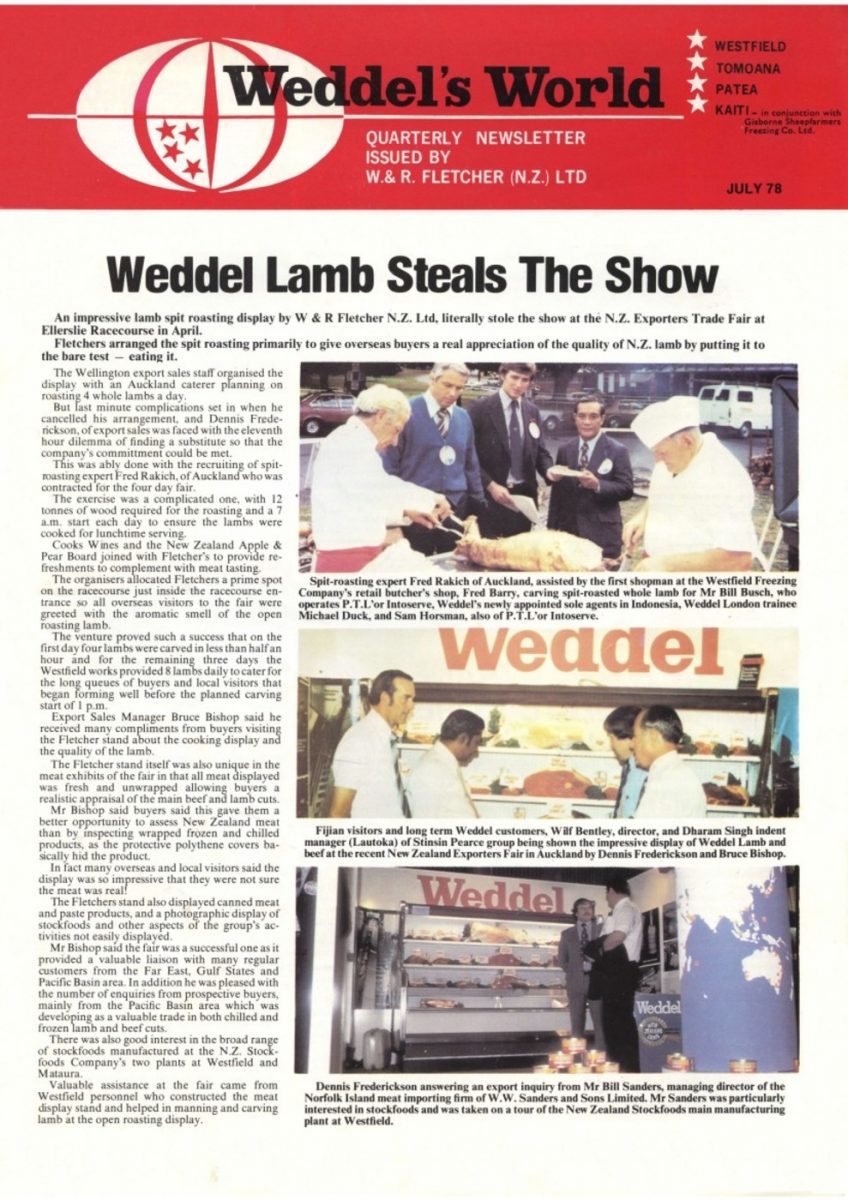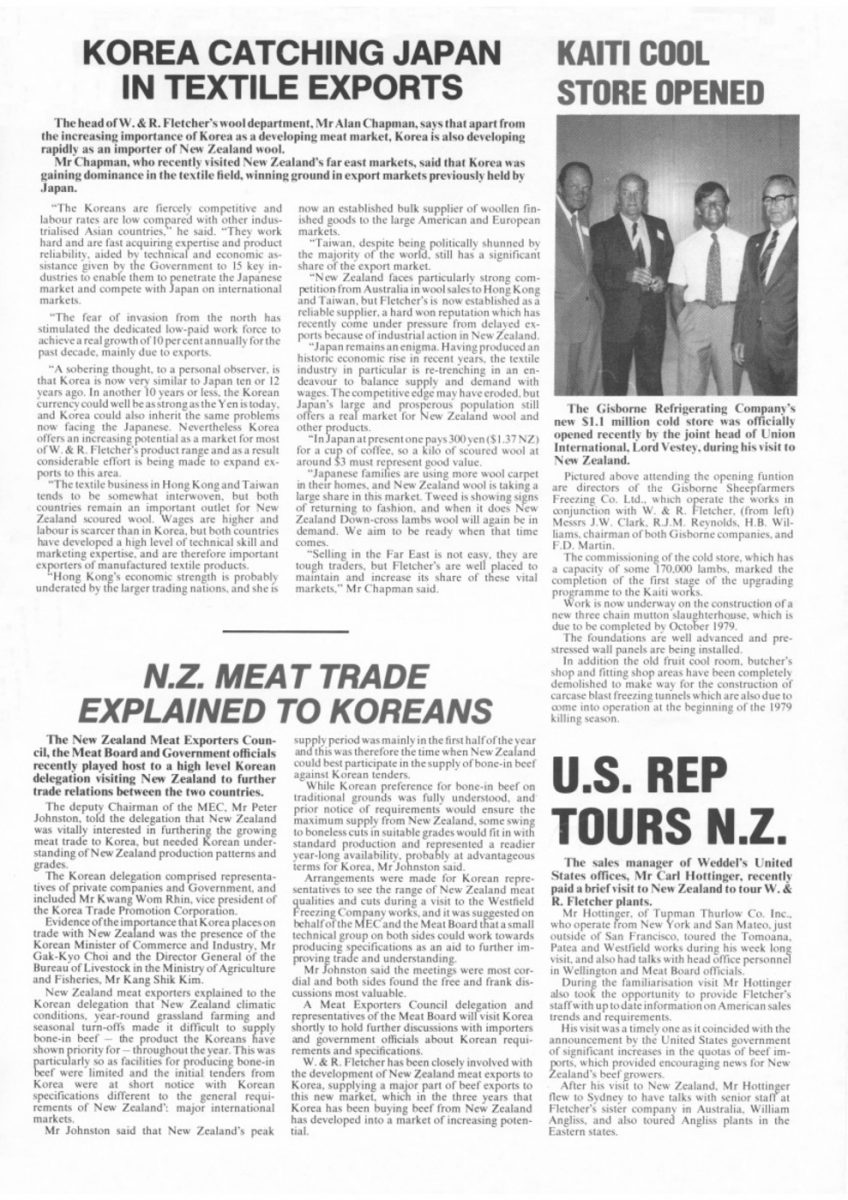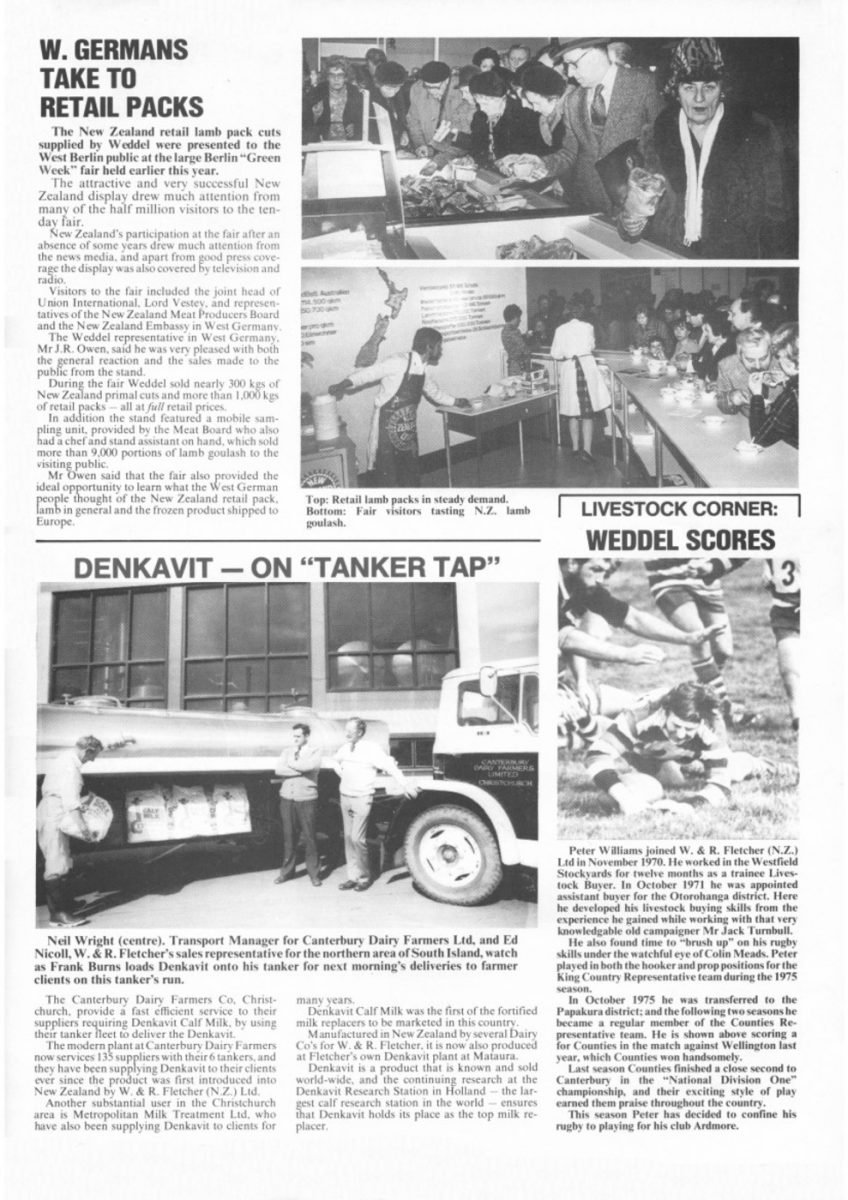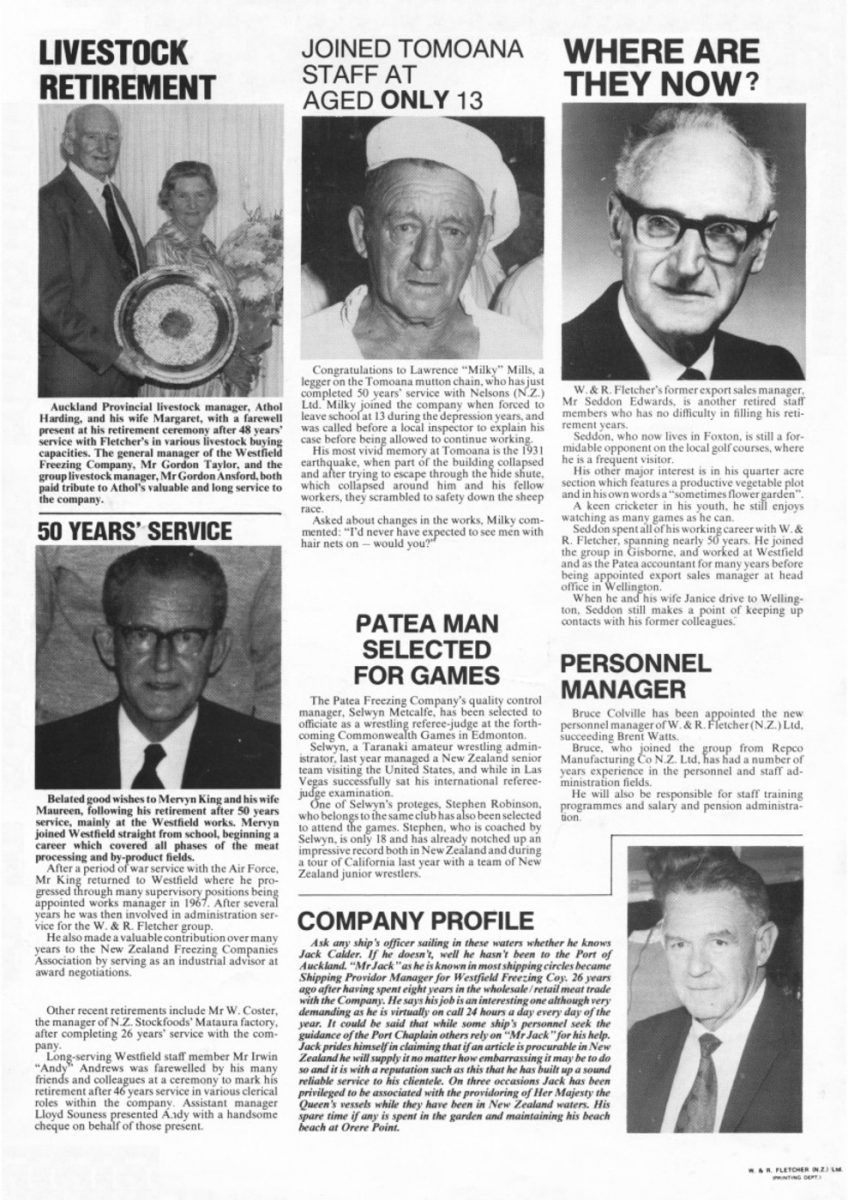- Home
- Collections
- SANDERS MJ
- Weddel's World
- Weddel's World 1978 - July
Weddel’s World 1978 – July
Weddel’s World
WESTFIELD
TOMOANA
PATEA
Kaiti – in conjunction with Gisborne Sheepfarmers Freezing Co. Ltd.
QUARTERLY NEWSLETTER
ISSUED BY
W.& R. FLETCHER (N.Z.) LTD
JULY 1978
Weddel Lamb Steals The Show
An impressive lamb spit roasting display by W & R Fletcher NZ. Ltd, literally stole the show at the NZ. Exporters Trade Fair at Ellerslie Racecourse in April.
Fletchers arranged the spit roasting primarily to give overseas buyers a real appreciation of the quality of NZ. lamb by putting it to the bare test – eating it.
The Wellington export sales staff organised the display with an Auckland caterer planning on roasting 4 whole lambs a day.
But last minute complications set in when he cancelled his arrangement, and Dennis Frederickson, of export sales was faced with the eleventh hour dilemma of finding a substitute so that the company’s commitment could be met.
This was ably done with the recruiting of spit-roasting expert Fred Rakich, of Auckland who was contracted for the four day fair.
The exercise was a complicated one, with 12 tonnes of wood required for the roasting and a 7 a.m. start each day to ensure the lambs were cooked for lunchtime serving.
Cooks Wines and the New Zealand Apple & Pear Board joined with Fletcher’s to provide refreshments to complement with meat tasting.
The organisers allocated Fletchers a prime spot on the racecourse just inside the racecourse entrance so all overseas visitors to the fair were greeted with the aromatic smell of the open roasting lamb.
The venture proved such a success that on the first day four lambs were carved in less than half an hour and for the remaining three days the Westfield works provided 8 lambs daily to cater for the long queues of buyers and local visitors that began forming well before the planned carving start of 1 p.m.
Export Sales Manager Bruce Bishop said he received many compliments from buyers visiting the Fletcher stand about the cooking display and the quality of the lamb.
The Fletcher stand itself was also unique in the meat exhibits of the fair in that all meat displayed was fresh and unwrapped allowing buyers a realistic appraisal of the main beef and lamb cuts.
Mr Bishop said buyers said this gave them a better opportunity to assess New Zealand meat than by inspecting wrapped frozen and chilled products, as the protective polythene covers basically hid the product.
In fact many overseas and local visitors said the display was so impressive that they were not sure the meat was real!
The Fletchers stand also displayed canned meat and paste products, and a photographic display of stockfoods and other aspects of the group’s activities not easily displayed.
Mr Bishop said the fair was a successful one as it provided a valuable liaison with many regular customers from the Far East, Gulf States and Pacific Basin area. In addition he was pleased with the number of enquiries from prospective buyers, mainly from the Pacific Basin area which was developing as a valuable trade in both chilled and frozen lamb and beef cuts.
There was also good interest in the broad range of stockfoods manufactured at the N.Z. Stockfoods Company’s two plants at Westfield and Mataura.
Valuable assistance at the fair came from Westfield personnel who constructed the meat display stand and helped in manning and carving lamb at the open roasting display.
Photo captions –
Spit-roasting expert Fred Rakich of Auckland, assisted by the first shopman at the Westfield Freezing Company’s retail butcher’s shop, Fred Barry, carving spit-roasted whole lamb for Mr Bill Busch, who operates P.T.L’or Intoserve, Weddel’s newly appointed sole agents in Indonesia, Weddel’s London trainee Michael Duck, and Sam Horsman, also of P.T.L’or Intoserve.
Fijian visitors and long term Weddel customers, Wilf Bentley, director, and Dharam Singh indent manager (Lautoka) of Stinsin Pearce group being shown the impressive display of Weddel Lamb and beef at the recent New Zealand Exporters Fair in Auckland by Dennis Frederickson and Bruce Bishop.
Dennis Frederickson answering an export inquiry from Mr Bill Sanders, managing director of the Norfolk Island meat importing firm of W. W. Sanders and Sons Limited. Mr Sanders was particularly interested in stockfoods and was taken on a tour of the New Zealand Stockfoods main manufacturing plant at Westfield.

KOREA CATCHING JAPAN IN TEXTILE EXPORTS
The head of W. & R. Fletcher’s wool department, Mr Alan Chapman, says that apart from the increasing importance of Korea as a developing meat market, Korea is also developing rapidly as an importer of New Zealand wool.
Mr Chapman, who recently visited New Zealand’s far east markets, said that Korea was gaining dominance in the textile field, winning ground in export markets previously held by Japan.
“The Koreans are fiercely competitive and labour rates are low compared with other industrialised Asian countries,” he said. “They work hard and are fast acquiring expertise and product reliability, aided by technical and economic assistance given by the Government to 15 key industries to enable them to penetrate the Japanese market and compete with Japan on international markets.
“The fear of invasion from the north has stimulated the dedicated low-paid work force to achieve a real growth of 10 percent annually for the past decade, mainly due to exports.
“A sobering thought, to a personal observer, is that Korea is now very similar to Japan ten or 12 years ago. In another 10 years or less, the Korean currency could well be as strong as the Yen is today, and Korea could also inherit the same problems now facing the Japanese. Nevertheless Korea offers an increasing potential as a market for most of W. & R. Fletcher’s product range and as a result considerable effort is being made to expand exports to this area.
“The textile business in Hong Kong and Taiwan tends to be somewhat interwoven, but both countries remain an important outlet for New Zealand scoured wool. Wages are higher and labour is scarcer than in Korea, but both countries have developed a high level of technical skill and marketing expertise, and are therefore important exporters of manufactured textile products.
“Hong Kong’s economic strength is probably underated by the larger trading nations, and she is now an established bulk supplier of woollen finished goods to the large American and European markets.
“Taiwan, despite being politically shunned by the majority of the world, still has a significant share of the export market.
“New Zealand faces particularly strong competition from Australia in wool sales to Hong Kong and Taiwan, but Fletcher’s is now established as a reliable supplier, a hard won reputation which has recently come under pressure from delayed exports because of industrial action in New Zealand.
“Japan remains an enigma. Having produced an historic economic rise in recent years, the textile industry in particular is re-trenching in an endeavour to balance supply and demand with wages. The competitive edge may have eroded, but Japan’s large and prosperous population still offers a real market for New Zealand wool and other products.
“In Japan at present one pays 300 yen ($l.37 NZ) for a cup of coffee, so a kilo of scoured wool at around $3 must represent good value.
“Japanese families are using more wool carpet in their homes, and New Zealand wool is taking a large share in this market. Tweed is showing signs of returning to fashion, and when it does New Zealand Down-cross lambs wool will again be in demand. We aim to be ready when that time comes.
“Selling in the Far East is not easy, they are tough traders, but Fletcher’s are well placed to maintain and increase its share of these vital markets,” Mr Chapman said.
N.Z. MEAT TRADE EXPLAINED TO KOREANS
The New Zealand Meat Exporters Council, the Meat Board and Government officials recently played host to a high level Korean delegation visiting New Zealand to further trade relations between the two countries.
The deputy Chairman of the MEC, Mr Peter Johnston, told the delegation that New Zealand was vitally interested in furthering the growing meat trade to Korea, but needed Korean understanding of New Zealand production patterns and grades.
The Korean delegation comprised representatives of private companies and Government, and included Mr Kwang Wom Rhin, vice president of the Korea Trade Promotion Corporation.
Evidence of the importance that Korea places on trade with New Zealand was the presence of the Korean Minister of Commerce and Industry, Mr Gak-Kyo Choi and the Director General of the Bureau of Livestock in the Ministry of Agriculture and Fisheries, Mr Kang Shik Kim.
New Zealand meat exporters explained to the Korean delegation that New Zealand climatic conditions, year-round grassland farming and seasonal turn-offs made it difficult to supply bone-in beef – the product the Koreans have shown priority for – throughout the year. This was particularly so as facilities for producing bone-in beef were limited and the initial tenders from Korea were at short notice with Korean specifications different to the general requirements of New Zealand’s major international markets.
Mr Johnston said that New Zealand’s peak supply period was mainly in the first half of the year and this was therefore the time when New Zealand could best participate in the supply of bone-in beef against Korean tenders.
While Korean preference for bone-in beef on traditional grounds was fully understood, and prior notice of requirements would ensure the maximum supply from New Zealand, some swing to boneless cuts in suitable grades would fit in with standard production and represented a readier year-long availability, probably at advantageous terms for Korea, Mr Johnston said.
Arrangements were made for Korean representatives to see the range of New Zealand meat qualities and cuts during a visit to the Westfield Freezing Company works, and it was suggested on behalf of the MEC and the Meat Board that a small technical group on both sides could work towards producing specifications as an aid to further improving trade and understanding.
Mr Johnston said the meetings were most cordial and both sides found the free and frank discussions most valuable.
A Meat Exporters Council delegation and representatives of the Meat Board will visit Korea shortly to hold further discussions with importers and government officials about Korean requirements and specifications.
W. & R. Fletcher has been closely involved with the development of New Zealand meat exports to Korea, supplying a major part of beef exports to this new market, which in the three years that Korea has been buying beef from New Zealand has developed into a market of increasing potential.
KAITI COOL STORE OPENED
The Gisborne Refrigerating Company’s new $1.1 million cold store was officially opened recently by the joint head of Union International, Lord Vestey, during his visit to New Zealand.
Pictured above attending the opening funtion [function] are directors of the Gisborne Sheepfarmers Freezing Co. Ltd., which operate the works in conjunction with W. & R. Fletcher, (from left) Messrs J. W. Clark, R. J. M. Reynolds, H. B. Williams, chairman of both Gisborne companies, and F. D. Martin.
The commissioning of the cold store, which has a capacity of some 170,000 lambs, marked the completion of the first stage of the upgrading programme to the Kaiti works.
Work is now underway on the construction of a new three chain mutton slaughterhouse, which is due to be completed by October 1979.
The foundations are well advanced and pre-stressed wall panels are being installed.
In addition the old fruit cool room, butcher’s shop and fitting shop areas have been completely demolished to make way for the construction of carcase blast freezing tunnels which are also due to come into operation at the beginning of the 1979 killing season.
U.S. REP TOURS N. Z.
The sales manager of Weddel’s United States offices, Mr Carl Hottinger, recently paid a brief visit to New Zealand to tour W. & R. Fletcher plants.
Mr Hottinger, of Tupman Thurlow Co. Inc., who operate from New York and San Mateo, just outside of San Francisco, toured the Tomoana, Patea and Westfield works during his week long visit, and also had talks with head office personnel in Wellington and Meat Board officials.
During the familiarisation visit Mr Hottinger also took the opportunity to provide Fletcher’s staff with up to date information on American sales trends and requirements.
His visit was a timely one as it coincided with the announcement by the United States government of significant increases in the quotas of beef imports, which provided encouraging news for New Zealand’s beef growers.
After his visit to New Zealand, Mr Hottinger flew to Sydney to have talks with senior staff at Fletcher’s sister company in Australia, William Angliss, and also toured Angliss plants in the Eastern states.

W. GERMANS TAKE TO RETAIL PACKS
The New Zealand retail lamb pack cuts supplied by Weddel were presented to the West Berlin public at the large Berlin “Green Week” fair held earlier this year.
The attractive and very successful New Zealand display drew much attention from many of the half million visitors to the ten-day fair.
New Zealand’s participation at the fair after an absence of some years drew much attention from the news media, and apart from good press coverage the display was also covered by television and radio.
Visitors to the fair included the joint head of Union International, Lord Vestey, and representatives of the New Zealand Meat Producers Board and the New Zealand Embassy in West Germany.
The Weddel representative in West Germany, Mr J.R. Owen, said he was very pleased with both the general reaction and the sales made to the public from the stand.
During the fair Weddel sold nearly 300 kgs of New Zealand primal cuts and more than 1,000 kgs of retail packs – all at full retail prices.
In addition the stand featured a mobile sampling unit, provided by the Meat Board who also had a chef and stand assistant on hand, which sold more than 9,000 portions of lamb goulash to the visiting public.
Mr Owen said that the fair also provided the ideal opportunity to learn what the West German people thought of the New Zealand retail pack, lamb in general and the frozen product shipped to Europe.
Top: Retail lamb packs in steady demand.
Bottom: Fair visitors tasting N. Z. lamb goulash.
DENKAVIT – ON “TANKER TAP”
Neil Wright (centre). Transport Manager for Canterbury Dairy Farmers Ltd, and Ed Nicoll, W. & R. Fletcher’s sales representative for the northern area of South Island, watch as Frank Burns loads Denkavit onto his tanker for next morning’s deliveries to farmer clients on this tanker’s run.
The Canterbury Dairy Farmers Co, Christchurch, provide a fast efficient service to their suppliers requiring Denkavit Calf Milk, by using their tanker fleet to deliver the Denkavit.
The modern plant at Canterbury Dairy Farmers now services 135 suppliers with their 6 tankers. and they have been supplying Denkavit to their clients ever since the product was first introduced into New Zealand by W. & R. Fletcher (N.Z.) Ltd.
Another substantial user in the Christchurch area is Metropolitan Milk Treatment Ltd, who have also been supplying Denkavit to clients for many years.
Denkavit Calf Milk was the first of the fortified milk replacers to be marketed in this country.
Manufactured in New Zealand by several Dairy Co’s for W. & R. Fletcher, it is now also produced at Fletcher’s own Denkavit plant at Mataura.
Denkavit is a product that is known and sold world-wide, and the continuing research at the Denkavit Research Station in Holland – the largest calf research station in the world – ensures that Denkavit holds its place as the top milk replacer.
LIVESTOCK CORNER: WEDDEL SCORES
Peter Williams joined W. & R. Fletcher (N.Z.) Ltd in November 1970. He worked in the Westfield Stockyards for twelve months as a trainee Livestock Buyer. In October 1971 he was appointed assistant buyer for the Otorohanga district. Here he developed his livestock buying skills from the experience he gained while working with that very knowledgeable old campaigner Mr Jack Turnbull.
He also found time to “brush up” on his rugby skills under the watchful eye of Colin Meads. Peter played in both the hooker and prop positions for the King Country Representative team during the 1975 season.
In October 1975 he was transferred to the Papakura district; and the following two seasons he became a regular member of the Counties Representative team. He is shown above scoring a [try] for Counties in the match against Wellington last year, which Counties won handsomely.
Last season Counties finished a close second to Canterbury in the “National Division One” championship, and their exciting style of play earned them praise throughout the country.
This season Peter has decided to confine his rugby to playing for his club Ardmore.

LIVESTOCK RETIREMENT
Auckland Provincial livestock manager, Athol Harding, and his wife Margaret, with a farewell present at his retirement ceremony after 48 years’ service with Fletcher’s in various livestock buying capacities. The general manager of the Westfield Freezing Company, Mr Gordon Taylor, and the group livestock manager, Mr Gordon Ansford, both paid tribute to Athol’s valuable and long service to the company.
50 YEARS’ SERVICE
Belated good wishes to Mervyn King and his wife Maureen, following his retirement after 50 years service, mainly at the Westfield works. Mervyn joined Westfield straight from school, beginning a career which covered all phases of the meat processing and by-product fields.
After a period of war service with the Air Force, Mr King returned to Westfield where he progressed through many supervisory positions being appointed works manager in 1967. After several years he was then involved in administration service for the W. & R. Fletcher group.
He also made a valuable contribution over many years to the New Zealand Freezing Companies Association by serving as an industrial advisor at award negotiations.
Other recent retirements include Mr W. Coster, the manager of N.Z. Stockfoods’ Mataura factory, after completing 26 years’ service with the company
Long-serving Westfield staff member Mr Irwin “Andy” Andrews was farewelled by his many friends and colleagues at a ceremony to mark his retirement after 46 years service in various clerical roles within the company. Assistant manager Lloyd Souness presented Andy with a handsome cheque on behalf of those present.
JOINED TOMOANA STAFF AT AGED ONLY 13
Congratulations to Lawrence “Milky” Mills, a legger on the Tomoana mutton chain, who has just completed 50 years’ service with Nelsons (N.Z.) Ltd. Milky joined the company when forced to leave school at 13 during the depression years, and was called before a local inspector to explain his case before being allowed to continue working.
His most vivid memory at Tomoana is the 1931 earthquake, when part of the building collapsed and after trying to escape through the hide shute, which collapsed around him and his fellow workers, they scrambled to safety down the sheep race.
Asked about changes in the works, Milky commented: “I’d never have expected to see men with hair nets on – would you?”
PATEA MAN SELECTED FOR GAMES
The Patea Freezing Company’s quality control manager, Selwyn Metcalfe, has been selected to officiate as a wrestling referee-judge at the forthcoming Commonwealth Games in Edmonton.
Selwyn, a Taranaki amateur wrestling administrator, last year managed a New Zealand senior team visiting the United States, and while in Las Vegas successfully sat his international referee-judge examination.
One of Selwyn’s proteges, Stephen Robinson, who belongs to the same club has also been selected to attend the games. Stephen, who is coached by Selwyn, is only 18 and has already notched up an impressive record both in New Zealand and during a tour of California last year with a team of New Zealand junior wrestlers.
WHERE ARE THEY NOW?
W. & R. Fletcher’s former export sales manager, Mr Seddon Edwards, is another retired staff members who has no difficulty in filling his retirement years.
Seddon, who now lives in Foxton, is still a formidable opponent on the local golf courses, where he is a frequent visitor.
His other major interest is in his quarter acre section which features a productive vegetable plot and in his own words a “sometimes flower garden”.
A keen cricketer in his youth, he still enjoys watching as many games as he can.
Seddon spent all of his working career with W. & R. Fletcher, spanning nearly 50 years. He joined the group in Gisborne, and worked at Westfield and as the Patea accountant for many years before being appointed export sales manager at head office in Wellington.
When he and his wife Janice drive to Wellington, Seddon still makes a point of keeping up contacts with his former colleagues.
PERSONNEL MANAGER
Bruce Colville has been appointed the new personnel manager of W. & R. Fletcher (N Z.) Ltd, succeeding Brent Watts.
Bruce, who joined the group from Repco Manufacturing Co N Z. Ltd, has had a number of years experience in the personnel and staff administration fields.
He will also be responsible for staff training programmes and salary and pension administration.
COMPANY PROFILE
Ask any ship’s officer sailing in these waters whether he knows Jack Calder. If he doesn’t, well he hasn’t been to the Port of Auckland. “Mr Jack” as he is known in most shipping circles became Shipping Providor Manager for Westfield Freezing Coy. 26 years ago after having spent eight years in the wholesale/retail meat trade with the Company. He says his job is an interesting one although very demanding as he is virtually on call 24 hours a day every day of the year. It could be said that while some ship’s personnel seek the guidance of the Port Chaplain others rely on “Mr Jack ” for his help. Jack prides himself in claiming that if an article is procurable in New Zealand he will supply it no matter how embarrassing it may be to do so and it is with a reputation such as this that he has built up a sound reliable service to his clientele. On three occasions Jack has been privileged to be associated with the providoring of Her Majesty the Queen’s vessels while they have been in New Zealand waters. His spare time if any is spent in the garden and maintaining his beach beach [bach] at Orere Point.
W. & R. FLETCHER (N.Z.) Ltd.
(PRINTING DEPT.)

Non-commercial use

This work is licensed under a Attribution-NonCommercial 3.0 New Zealand (CC BY-NC 3.0 NZ).
Commercial Use
Please contact us for information about using this material commercially.Can you help?
The Hawke's Bay Knowledge Bank relies on donations to make this material available. Please consider making a donation towards preserving our local history.
Visit our donations page for more information.
Description
Surnames in this newsletter –
Andrews, Barry, Bentley, Bishop, Burns, Busch, Calder, Chapman, Choi, Clark, Colville, Coster, Duck, Edwards, Frederickson, Harding, Horsman, Hottinger, Johnston, Kim, King, Martin, Meads, Metcalfe, Mills, Nicoll, Owen, Pearce, Rakich, Reynolds, Rhin, Robinson, Sanders, Singh, Souness, Taylor, Turnbull, Vestey, Watts, Williams, Wright










Do you know something about this record?
Please note we cannot verify the accuracy of any information posted by the community.